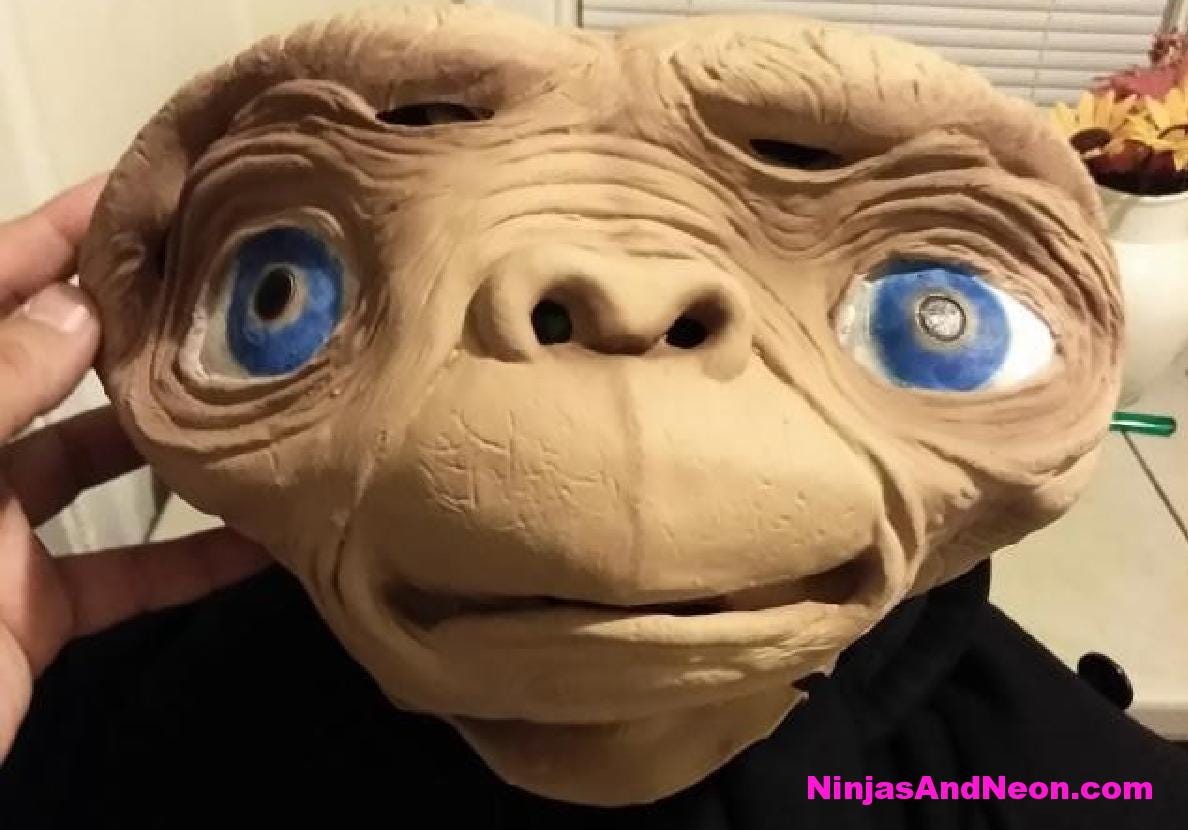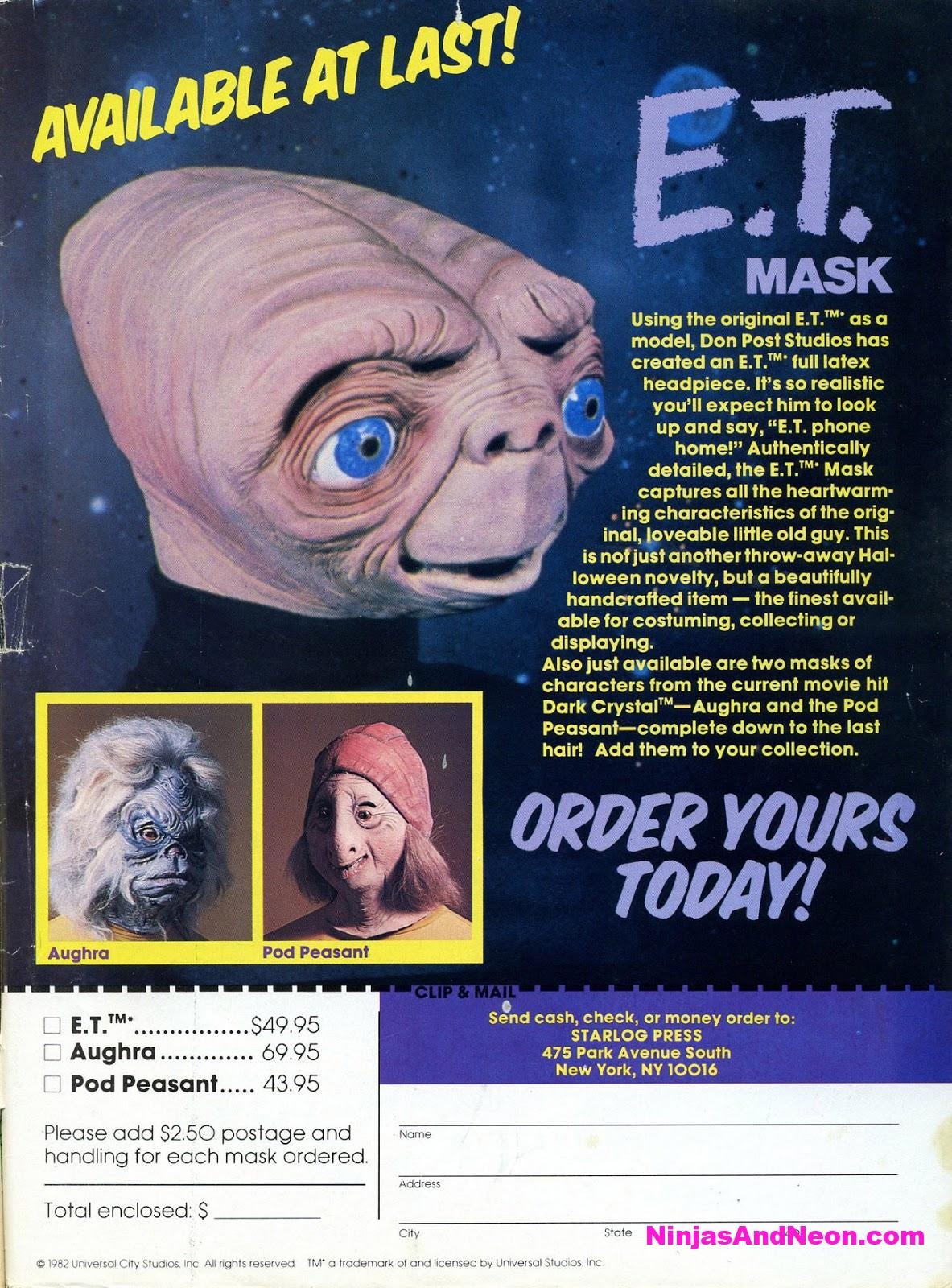Don Post's E.T. Mask
It was, quite literally, out of this world.
A lot of people associate the film E.T. the Extra-Terrestrial with Halloween, despite the fact that it was released in June of 1982. The confusion is most likely due to the film’s setting which takes place in the fall and contains a scene in which siblings Elliott, Michael, and Gertie takes E.T. trick-or-treating on Halloween. One of the film’s biggest laughs comes when E.T. has a brief chance encounter with a child dressed as Yoda and mistakes him for another alien — a personal nod from director Steven Spielberg to his line time friend and collaborator, George Lucas.
The story of E.T. and his quest to return home became one of the most successful films of all time. E.T. was everywhere that summer, and when I returned to school later that fall I saw kids wearing E.T. t-shirts, writing in E.T. notebooks, and carrying E.T. lunchboxes. A short time later when Halloween rolled around, millions of kids wanted to dress up as the cuddly brown alien.
Although most people associate Ben Cooper’s name with those traditional Halloween-in-a-box costumes, it was Cooper competitor Collegeville who snagged the coveted E.T. costumes license that Halloween. Collegeville’s costume included a plastic mask of E.T.’s face and the traditional plastic smock with a rather green looking E.T. on the front, along with the words “E.T. the Extra-Terrestrial” printed on it for those who had been living under a rock (or on another planet) in 1982 and did not recognize the popular character.
For adults (or kids with a larger Halloween budget than I had), another option was the latex rubber E.T. mask produced by Don Post Studios. Don Post, sometimes referred to as the Godfather of Halloween, was known for his lifelike, beautiful, and often terrifying rubber Halloween masks. Don Post Studios began selling rubber masks in 1938 until they finally closed their doors 2012. If you’ve ever opened your door on Halloween night, there’s a pretty good chance you’ve seen some of his work.
The biggest problem with creating an E.T. mask is that E.T.’s head is anatomically very different from a human’s. The skull is quite elongated unlike a normal person’s, with the facial features protruding far from the neck. The mask from Post maintains the authentic shape, which creates another problem — E.T.’s mouth, nose, and most importantly, eyes, are far away from the person wearing the mask, making it impossible to see out. Don Post solved this issue by cutting molded slits in the mask’s eyebrows that line up with the wearer’s eyes, allowing him or her to see out through the front of the mask. While the eye slits look very pronounced in well-lit pictures, they were much less noticeable when trick-or-treating in the dark.
In magazine ads, Don Post Studios described the mask as being “so realistic you’ll expect him to look up and say, ‘E.T. phone home!'” The ad also mentions that the mask is more than just another throw-away Halloween novelty, and that owners can use it for costuming, collecting, or displaying. The price for the mask in this ad from 1982 is $49, which according to an online inflation calculator would cost $139 today. While that price may sound steep, each mask was made by hand, including the air brushed eyes and details.
Despite the hefty price, Don Post’s E.T. mask was a hit. By the beginning of October, the studio had already received 60,000 orders for E.T. masks, far more than they could produce before Halloween. According to a news article from the time, Post estimated they could ship between 20k-25k masks prior to Halloween. Nothing says “trick-or-treat” more than receiving your expensive E.T. mask in the middle of November.






I wanted one of these so badly when I was a kid. I have encountered a few as an adult, but I hate to admit it, long after my obsession with the perfect Halloween mask has passed.